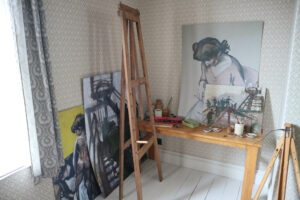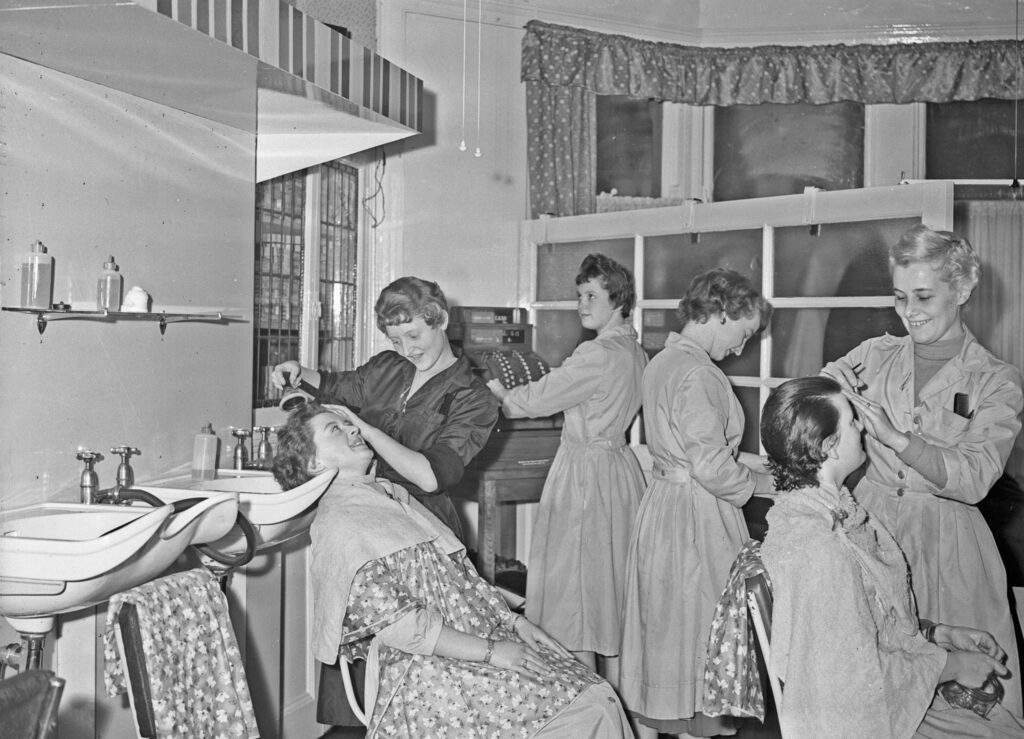Complete
Hairspray, hours of sitting underneath a hairdryer and tricky home perms, hair was big in the 1950s… literally!
Our 1950s Front Street Terrace includes a hairdresser’s in a replica of an end-terrace shop from Bow Street in Middlesbrough.

Visitors can walk into a typical 1950s waiting area, get their hair styled by one of our engagers and get their picture taken under the row of 50s hair dryers from our collection.
We’re sharing the story of 1950s hairdressing in the exhibit, including where people would have trained, as well as women’s fashion and beauty during the decade. Plus, visitors can discover fascinating objects from Beamish’s collection, including our styling chairs.
The Remaking Beamish Team has been gathering memories and photographs of 1950s hairdressing for the exciting new building.
The team has worked with Betty and Ian Macpherson, who were the owners of the end-terrace shop we have replicated, then called Elizabeth’s Hair Fashions, for 37 years. The couple bought the salon in 1973 and, although they did not own the shop in the 1950s, their memories of the decade and Betty’s early career have helped to shape the stories we are telling in the exhibit.
TV, magazine and radio adverts for hair products were very common during the 1950s, targeting men, women and teenagers. They would emphasise the importance of clean hair for social success. Shampoo adverts targeted teenagers – their new-found 50s independence meant they had spending money and could buy products.
A lot of salons adopted a “modern” design style in the 1950s, using pastel colours or chrome, which were frequently associated with cinema design of the decade – something which was becoming increasingly popular at the time. North East salons were keen to stress that they were just as fashionable as high-end salons in London or Paris, with all the latest fixtures and fittings.
There was a defined gender split, with salons serving women and children, whereas men’s hairdresser’s were usually referred to as barber’s. Whilst under the dryer, women could take advantage of the other services hairdressers often offered – manicures, hand massages, makeup and even facials.
The hairdresser’s was such an important space for women in the 1950s, the exhibit allows us to tell the story of women’s growing independence and how important that was.
Even though women would have not had a great deal of money to spare and it was much cheaper to do your hair at home, we’ve heard a lot of stories about how women would have put money aside to maintain their hair by visiting a salon. One way of doing this was through ‘perm clubs’, where each woman paid in a couple of shillings a week. This meant the hairdresser could work through each woman in the ‘club’ in turn, but costs could be spread over a number of weeks.
Front Street terrace also includes a fish and chip shop and John’s Café, a popular ice cream parlour.
No. 2 Front Street is a recreation of the former home of celebrated North East artist Norman Cornish, who lived there from 1953 to 1967. The exhibit also tells the story of the Spennymoor Settlement, which was part of a wider national movement and nurtured the talents of artists, writers and poets including Norman, Tom McGuinness, Bob Heslop and Bert Dees, and playwright Sid Chaplin among others.
Women’s 50s Hair
Women were expected to keep up appearances, from their clothes and makeup, to their hair and house – being a 50s “happy housewife” wasn’t easy. This was reflected in events such as National Hair and Beauty Week which took place in March throughout the 1950s, with big displays of the latest trends in hair and makeup in the centre of Newcastle followed by competitions and dances.
Bouffants became popular in the 50s. Hair would be set in rollers (sometimes clean juice cans!) and teased (backcombed) to add volume. Women would often go out in public with their hair in rollers, ready for going out later. English hairdresser Raymond Bessone, nicknamed Mr Teasy Weasy, is credited with launching this style. This led to soaring sales of hairspray and rollers, with hair being lacquered in place to achieve the look. Raymond also introduced new styles such as the Champagne Bubble Cut of 1956, the Viking Line of 1959 and the Boom Line in 1960.
Hairdressers who worked in the 50s have noted that the floors of the salons “became tacky” with hairspray residue. The lacquer also clung to their clothing and skin, and, because of these effects, some stylists resorted to making their own hairspray from sugar and water.
Many women over 20 tended to get short, “elfin” haircuts that were sometimes called Italian cuts or poodle cuts. Styles were influenced by actresses such as Audrey Hepburn and Marilyn Monroe.
Advances in technology in the 1950s meant that hairdressers had more sophisticated means to style hair which could not be done to the same level at home, for example, the permanent wave machines, hair dryers and new hair colouring formulations. A professional permanent wave required special training and took hours to complete. How often you had your hair permed would depend on your disposable income – a newspaper at the time reported some women making a perm last six months whereas others had a fresh perm every eight weeks.
Do-it-yourself hair colouring kits also became more affordable and offered a wider selection of natural colours. New and improved products made it easier to hide grey hair and lighten hair without bleaching first, and allowed for more privacy, with many women preferring to be discreet about their hair dyeing during the decade.
The 50s also marked the creation of a practical hair dryer for home use (although the user still had to sit under the dryer!). These dryers were made of plastic and came in pastel colours, which could be co-ordinated with the consumer’s bathroom.
Straightening products also became easier, safer to use, and more convenient.
Men’s 50s Hair
During the 1950s, popular men’s styles included the flattop crew cut, ducktail Princeton cut and pompadour. Barber shops used tonics, oils and washes, and offered professional shaving. Technology introduced during the decade, however, meant that home shavers did become more accessible and safer to use.
The dominant product in men’s hairstyling during the 1950s was Brylcreem, which had appeared in 1928 and remained highly popular until the 1960s. Adverts in the 50s and 60s had the jingle “Brylcreem, a little dab’ll do ya”.
For the first half of the century, lanolin was a common ingredient in hair products for men. Greasy or waxy products worked well for the popular “wet look” style, such as the pompadour.
If you have any memories of hairdressing during the 1950s or if you visited the Bow Street shop in Middlesbrough, Beamish would love to hear from you. Contact Natasha Anson, Remaking Beamish Project Officer – Community Participation, email: natashaanson@beamish.org.uk.
Related Exhibits
No. 2 Front Street

No. 2 Front Street is a recreation of the former home of North East artist Norman Cornish and tells the story of the Spennymoor Settlement of artists, writers and poets.
Read moreMiddleton's Quality Fish and Chips

A fried fish shop has been replicated in The 1950s Town to serve up this popular 1950s treat.
Read moreJohn’s Café
From ice cream and Oxo to rock ‘n’ roll and courting couples, the interior of a popular ice cream parlour has been given a new home in Beamish’s 1950s Town.
Read more


